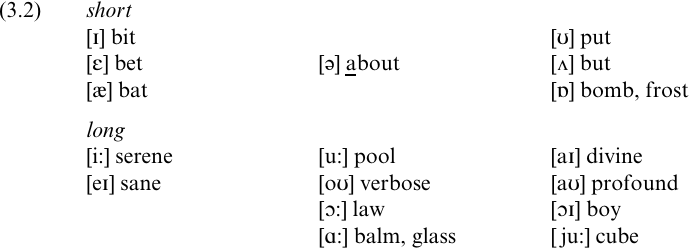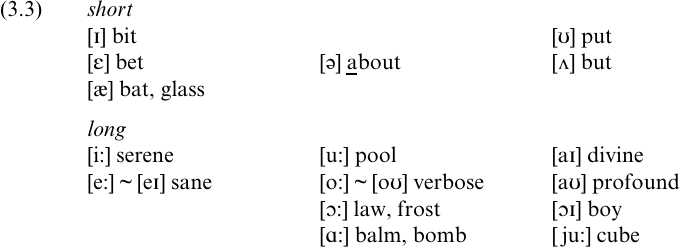


 Grammar
Grammar
 Tenses
Tenses
 Present
Present
 Past
Past
 Future
Future
 Parts Of Speech
Parts Of Speech
 Nouns
Nouns
 Verbs
Verbs
 Adverbs
Adverbs
 Adjectives
Adjectives
 Pronouns
Pronouns
 Pre Position
Pre Position
 Preposition by function
Preposition by function 
 Preposition by construction
Preposition by construction
 Conjunctions
Conjunctions
 Interjections
Interjections
 Grammar Rules
Grammar Rules
 Linguistics
Linguistics
 Semantics
Semantics
 Pragmatics
Pragmatics
 Reading Comprehension
Reading Comprehension|
Read More
Date: 2024-04-12
Date: 2024-02-17
Date: 19-3-2022
|
We attempted to strengthen the constraints usually assumed in Lexical Phonology, and to streamline the architecture of the lexical component, reducing it to two levels. However, these alterations were mainly made on general theoretical grounds, and were largely independent of actual phonological analyses, then, we turn to the application of the constraints. Specifically, I shall propose a revised account of the Modern English Vowel Shift Rule (VSR), which adheres to the principles that underlying and lexical representations should be identical in non-alternating and underived forms. This reanalysis will have implications for various other aspects of the English vowel phonology, including the analysis of surface diphthongs, and the derivation of the [jū] sequence, and will furthermore indicate that synchronic rules can differ markedly from the historical changes which originally caused the variation they describe, a hypothesis to be developed later. Finally, even given the constraints of LP, dubious cases will inevitably arise. For instance, alternations may exist in a language, but the time depth from the creation of these alternating forms may be so great, and the forms involved so few, that speakers may be unable to discern a synchronically productive pattern. The adoption of a more concrete phonology may enforce a division between those alternations which are derivable by rule from a common underlier and those which are better treated as stored variants, and I shall show below that a less abstract formulation of VSR clarifies the difficult area of supposed `regularity' for Modern English verbs.
Before turning to VSR, we revisit the vowel system of Halle and Mohanan (1985), which shows the main problems that a revised account of English vowel phonology must confront (see (3.1)).

Halle and Mohanan are primarily concerned with General American, but claim their underlying vowel system is also appropriate for RP; this assignment of a single underlying phonological system to related dialects was a characteristic of SGP which Halle and Mohanan carry over into LP, and which we shall challenge below. As a result of this assumption, Halle and Mohanan propose a single underlying representation for the vowel in balm, and one for bomb, despite considerable surface variation. Absolute neutralization means that [jū] in cube and [jū] in venue are derived from distinct underlying vowels, while all underlyingly tense vowels take a free ride through VSR. The revision of Vowel Shift below will address all these issues, directly or indirectly.
Note first, however, that the terms `RP' and `General American' are both to some extent controversial. Gimson (1973: 116) describes RP as `a somewhat fictional standard [that] has been in existence for centuries and was finally sanctified some forty years ago by the BBC's Advisory Committee on Spoken English'. This is of some concern to Ramsaran (1990: 180-1), who comments that `Since RP is the only accent that I have ever spoken with, I have a subjective conviction that it exists. This is, of course, an indefensibly circular statement. More objectively, I could say that I discovered as an undergraduate that my native accent was fairly accurately described in Gimson (1962).' In a sense, both Gimson and Ramsaran are right. Ohala's (1974) assumption that individual speakers may have different underlying representations, for instance, will render `somewhat fictional' any system not based on detailed observation of the usage of a single speaker. Yet to make our conclusions interesting and significant, we surely have to extrapolate beyond this detailed level. The fictionality of RP is also assured if we regard it as fixed; the truth is that RP is changing like any other variety, with more conservative versions having, for instance, [ɐ]in blood and guts while more innovative ones have [Λ], and increasing glottalization of stops among younger speakers contributing to the creation of a continuum with London English. With these caveats in mind, phonologists, phoneticians and sociolinguists still see RP as a useful idealization: Nolan and Kerswill (1990: 316), for instance, define it as `the prestige accent of South East England which also serves as a prestige norm in varying degrees elsewhere in England.' I assume for RP the surface vowel system in (3.2) (excluding for the present vowels before historical /r/, which will be discussed later), although I shall from time to time refer to other variants.

Similarly, I use `General American' (GenAm) to refer to a variety with the surface vowel system in (3.3), again with some regional variants which will be discussed below. For the low vowels at least, the system in (3.3) is identical with that of Upstate New York/ Eastern Pennsylvania/ South Midland described by Kurath and McDavid (1961: 7).

|
|
|
|
التوتر والسرطان.. علماء يحذرون من "صلة خطيرة"
|
|
|
|
|
|
|
مرآة السيارة: مدى دقة عكسها للصورة الصحيحة
|
|
|
|
|
|
|
هيأة المساءلة والعدالة: مؤتمر ذاكرة الألم يوثّق سنوات القهر التي عاشها العراقيون إبّان الحكم الجائر
|
|
|